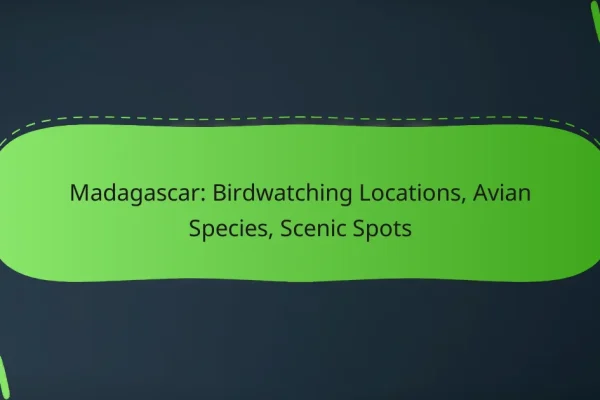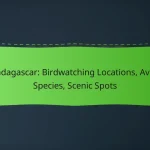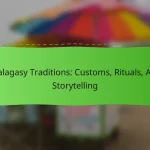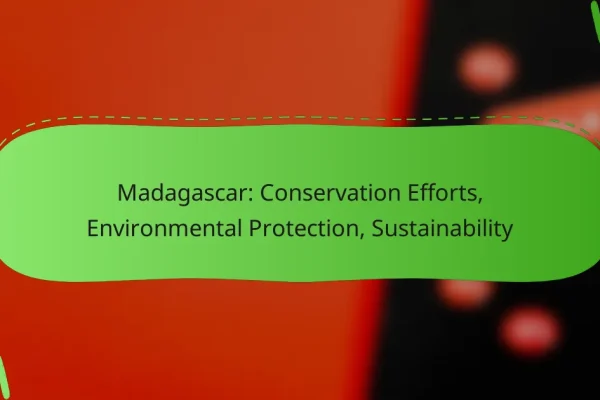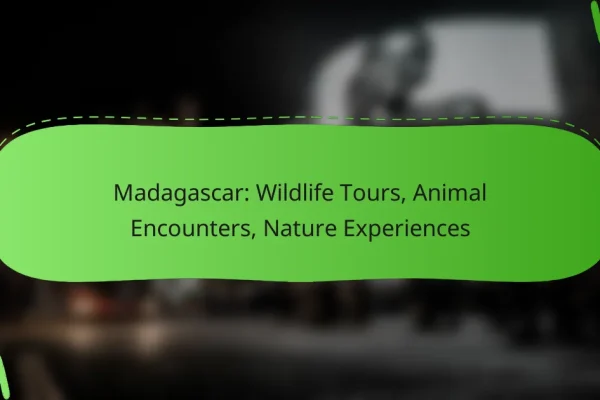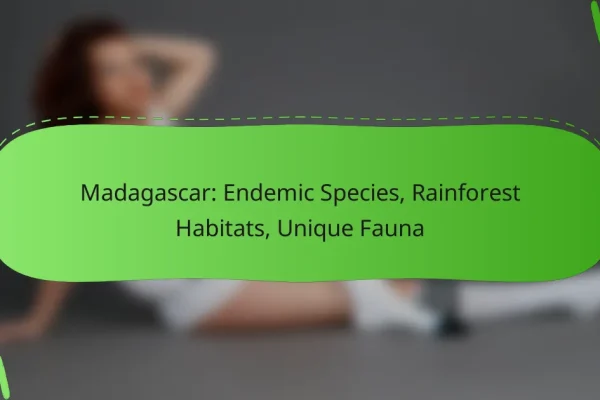What wildlife experiences are available in Madagascar?
Madagascar offers a variety of wildlife experiences that allow visitors to engage with its unique biodiversity. From guided tours to eco-lodges, there are numerous ways to explore the island’s rich flora and fauna.
Guided wildlife tours
Guided wildlife tours in Madagascar provide an immersive experience led by knowledgeable local guides. These tours often focus on specific regions, such as rainforests or coastal areas, allowing participants to see endemic species like lemurs and chameleons up close.
When choosing a tour, consider the duration, group size, and specific wildlife interests. Many tours include transportation and meals, but it’s wise to confirm what is included in the package.
National park explorations
Exploring Madagascar’s national parks is essential for wildlife enthusiasts. Parks such as Andasibe-Mantadia and Ranomafana are renowned for their biodiversity and offer well-marked trails for hiking.
Entry fees for national parks typically range from 10,000 to 50,000 Malagasy Ariary (MGA), depending on the park. It’s advisable to visit during the dry season, from May to October, for the best wildlife sightings.
Wildlife photography workshops
Wildlife photography workshops in Madagascar cater to both beginners and experienced photographers. These workshops often take place in stunning locations, providing opportunities to capture the island’s unique wildlife in their natural habitats.
Participants should bring their own camera equipment and be prepared for varying weather conditions. Workshops typically last several days and include guidance on techniques for photographing wildlife effectively.
Eco-lodges and sustainable stays
Staying in eco-lodges is a great way to experience Madagascar’s wildlife while supporting sustainable tourism. These lodges often prioritize environmental conservation and community engagement, providing a more authentic experience.
Prices for eco-lodges can vary widely, generally ranging from $30 to $200 per night, depending on amenities and location. Look for lodges that offer guided nature walks or wildlife observation opportunities to enhance your stay.
What unique species can be found in Madagascar?
Madagascar is home to a remarkable array of unique species that cannot be found anywhere else on Earth. This biodiversity is largely due to the island’s isolation, which has allowed species to evolve independently over millions of years.
Lemurs
Lemurs are perhaps the most iconic of Madagascar’s wildlife, with over 100 species ranging from the tiny mouse lemur to the larger indri. These primates are known for their social structures and vocalizations, making them fascinating to observe in their natural habitats. Many species are endangered due to habitat loss and hunting, highlighting the need for conservation efforts.
Chameleons
Madagascar is renowned for its diverse chameleon population, which includes about half of the world’s species. These reptiles are famous for their ability to change color, which they use for communication and temperature regulation. Visitors can find chameleons in various habitats, from rainforests to dry deciduous forests, but they are increasingly threatened by deforestation.
Fossa
The fossa is Madagascar’s largest carnivorous mammal and resembles a small cougar. It plays a crucial role in the ecosystem as a predator of lemurs and other small animals. Although the fossa is not endangered, its population is affected by habitat destruction and human encroachment, making it important to protect its natural environment.
Baobab trees
Baobab trees are a symbol of Madagascar’s unique landscape, with their distinctive thick trunks and sprawling branches. These trees can live for over a thousand years and are vital for local ecosystems, providing food and shelter for various species. The Avenue of the Baobabs is a popular tourist destination, showcasing these magnificent trees and emphasizing the need for their conservation.
How to plan a wildlife trip to Madagascar?
Planning a wildlife trip to Madagascar involves choosing the right time to visit, creating a suitable itinerary, and understanding travel regulations. Consider the unique ecosystems and diverse species when mapping out your adventure.
Best travel seasons
The best time to visit Madagascar for wildlife viewing is during the dry season, which typically runs from April to November. This period offers more accessible trails and better opportunities to spot animals, as many species are more active and visible.
However, the months of September to November are particularly ideal for seeing baby lemurs and other wildlife. Be mindful that the wet season, from December to March, can lead to flooding and road closures, making travel more challenging.
Itinerary suggestions
A well-rounded itinerary should include visits to key national parks such as Andasibe-Mantadia, Ranomafana, and Isalo. Each park offers unique wildlife experiences, from the iconic lemurs to diverse bird species and stunning landscapes.
Consider spending at least 10 to 14 days to explore these areas thoroughly. A sample itinerary might include 3 days in Andasibe for lemur spotting, followed by 4 days in Ranomafana for hiking and birdwatching, and concluding with 3 days in Isalo for its dramatic scenery.
Travel permits and regulations
Traveling in Madagascar requires a tourist visa, which can often be obtained upon arrival or online. Ensure your passport is valid for at least six months beyond your planned departure date.
Some national parks may require additional permits for entry, especially for guided tours. Always check the specific regulations for each park before your visit to avoid any surprises.
What are the conservation efforts in Madagascar?
Conservation efforts in Madagascar focus on protecting its unique biodiversity through various strategies, including establishing protected areas, engaging local communities, and forming international partnerships. These initiatives aim to preserve the island’s rich wildlife and ecosystems while addressing the challenges posed by deforestation and habitat loss.
Protected areas and reserves
Madagascar has established numerous protected areas and reserves to safeguard its unique flora and fauna. These areas cover approximately 10% of the country’s land and include national parks, special reserves, and world heritage sites. Notable examples are Andasibe-Mantadia National Park and Ranomafana National Park, which are critical habitats for many endemic species.
Management of these protected areas often involves strict regulations to limit human activities that could harm the environment. Visitors should be aware of these rules and respect the natural habitats to contribute to ongoing conservation efforts.
Community-based conservation programs
Community-based conservation programs in Madagascar empower local populations to participate in protecting their environment. These initiatives often provide training and resources to help communities manage natural resources sustainably while benefiting economically from eco-tourism and sustainable agriculture.
Successful programs encourage local stewardship of wildlife and habitats, fostering a sense of ownership and responsibility. Engaging communities in conservation can lead to more effective and lasting protection of Madagascar’s biodiversity.
International partnerships
International partnerships play a crucial role in Madagascar’s conservation efforts by providing funding, expertise, and support for various projects. Organizations such as the World Wildlife Fund (WWF) and Conservation International collaborate with the Malagasy government and local NGOs to implement conservation strategies.
These partnerships often focus on research, capacity building, and the development of sustainable practices that benefit both wildlife and local communities. By leveraging global resources, Madagascar can enhance its conservation initiatives and address the pressing challenges it faces.
What are the best locations for nature photography in Madagascar?
Madagascar offers stunning locations for nature photography, with unique landscapes and diverse wildlife. Key spots include the Avenue of the Baobabs, Andasibe-Mantadia National Park, and Isalo National Park, each providing distinct photographic opportunities.
Avenue of the Baobabs
The Avenue of the Baobabs is an iconic site in Madagascar, famous for its towering baobab trees that create a breathtaking landscape. This location is particularly striking at sunrise and sunset when the light enhances the trees’ silhouettes against the sky.
When planning a photography trip to this site, consider visiting during the dry season, from May to October, for clearer skies and better visibility. Bring a tripod for stability, especially in low light conditions, and experiment with different angles to capture the grandeur of these ancient trees.
Be mindful of the local environment; stick to marked paths to preserve the area and respect the natural habitat. Engaging with local guides can also enhance your experience, providing insights into the ecology and history of the baobabs.
